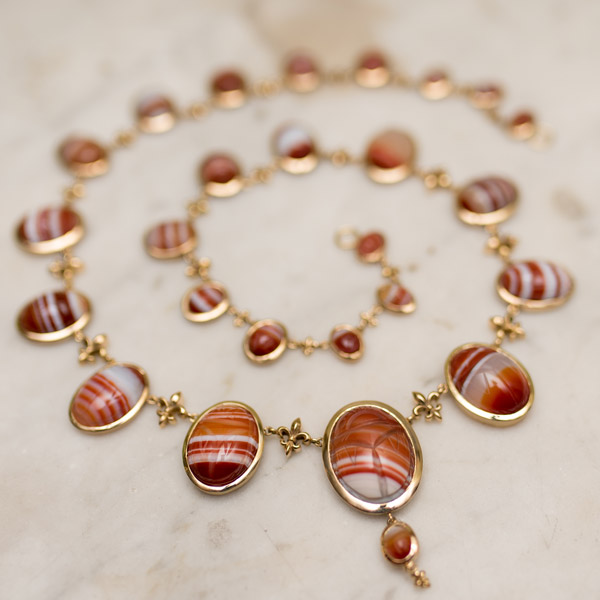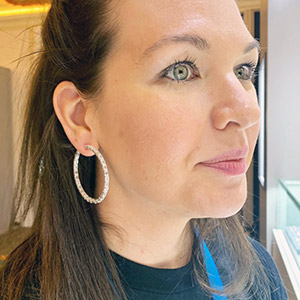
I’d like to talk about a gemstone I know absolutely nothing about. Or at least I didn’t, until I set out to write this and did a little digging to learn more. That stone is one of August’s birthstones: sardonyx.
Arguably, sardonyx is the birthstone of August. With a history that dates back more than 4,000 years, it’s the original birthstone of the month—though you wouldn’t know it, given how much attention peridot and spinel are given.
I visited my favorite website for learning about gemstones—GIA, naturally—to discover a bit more about this ancient gem, and though I definitely came away with some cool facts, I still feel a bit mystified by it—presumably because it’s simply not a stone I see all that often.
Sardonyx is like a layer cake of two types of chalcedony: sard and onyx. That’s where it gets those cool stripes; they’re an alternating pattern of the two stones, one—onyx—very well-known, and the other—sard—well, less so. So there’s another rabbit hole to fall down: What is sard? Simple enough—a translucent chalcedony in an orangish, reddish, brownish hue.
Sardonyx, in a word, is cool. It’s got this laid-back desert vibe that feels so peaceful and low-maintenance. It’s beautiful to look at, though, as I understand it, not particularly valuable, which might explain its lack of popularity.
Still, why don’t more jewelers use it? And furthermore, why haven’t more people heard of it? Even some of the most experienced gemstone designers I spoke to were hazy on the gem, so presumably most consumers have no clue about it.
I put out a call for designers and brands to send me their sardonyx jewelry creations. And guess what I got? Nada. Zilch. Zip.
So I did a little searching of my own and came across Emily Marquis, a jewelry designer based in Stonington, Conn., who also runs a jewelry academy in the area. She had the most beautiful sardonyx scarab necklace, one of the finest examples of the gem I’ve seen in my searches (and also amazing because it features scarabs). She was kind enough to talk with me a little bit about the gemstone, lending me further knowledge in my quest for more about it.
JCK: How often do you design with sardonyx? What do you like about the stone?
Emily Marquis: The sardonyx stone for me brings levels of symbolism. A stone of strength and protection, courage and happiness, communication and stability. After I had finished this [scarab necklace] and did a little research, those all felt very true to the journey I’d been on while designing and fabricating this piece. I was initially attracted to the orange and white bands when I had first discovered these vintage scarabs three years ago, and it took me all three years to collect this graduated set, each from a separate costume scarab bracelet or brooch from the 1920s to the 1970s. Opposed to the other shades of sardonyx and the banded agates (natural and dyed), the orange struck me: There’s a bold and regal bit about it, as well as a known commonness to the fact that it’s found in the earth that way. It was very popularly used for cameos, but the bands were not showcased.
Despite it being an official birthstone for August, it’s not one seen too often! Any thoughts as to why more jewelers don’t work with the gem?
We see a large amount of banded agate in antique Scottish jewelry (1700s–1900s), then it pops up again in global—France, Britain, U.S., Japan—vintage costume jewelry (1920–1970s), and we’re starting to see it again globally online. I’m sure something to do with the “rarity” of the stone is that opaque stones, especially banded agates, are akin to river rock and less luxurious than your precious stones or translucent faceted stones. But I think there is a bit of a timely cottage-core thing happening right now where these stones pop back into fashion: People getting back to their roots. We saw that with the noble Georgians fantasizing about being farmers, we see it with the beginnings of Renaissance fairs and heritage festivals in the 1950s to 1970s, and we’re seeing it again through Instagram and the mass evacuations from cities to the countryside.
Any other rare (or lesser-known) stones you enjoy working with?
I really enjoy using the lavender and periwinkle hues of chalcedony, inclusionless rock crystal, unusually banded or multicolored tourmalines, gray and purple spinel, and Washington nephrite jade. While I wouldn’t call them rare, they are less common, and I find myself needing to do a lot of education on them compared to other stones like sapphire, amethyst, ruby, and peridot. Much of our work lately has been seeking smaller stonecutters, transparent operation (mine-to-bench) gem dealers, vintage or reclaimed stones from old settings.
So, while it sounds like we won’t be seeing too many sardonyx jewels—particularly in fine jewelry—it’s always fun to learn new things, and I look forward to the next gemstone that stumps me (surely there will be many).
Top: Rivière necklace in 18k yellow gold with 26 vintage sardonyx scarab cabochons, $25,000; Emily Marquis Designs
Follow JCK on Instagram: @jckmagazineFollow JCK on Twitter: @jckmagazine
Follow JCK on Facebook: @jckmagazine






